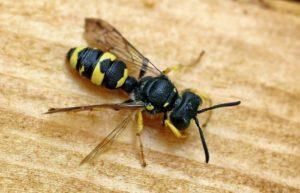Sand burrowing wasps - a subspecies that lives in nests
There are thousands of varieties of wasps. They differ in their behavior, way and way of life. Burrowing wasps get their name from the fact that they make their homes in the sand.
Content
General description of burrowing wasps
Representatives of burrowing wasps are a large group. They are distributed everywhere, except for cold regions and highlands. According to the name, their way of life is to dig holes. But there are individuals that are happy to be placed in nests, hollows or stems.
Appearance
Most representatives of the species are medium in size, 30 to 60 mm long. The color is predominantly black, the stripes may be yellow or red. On the pronotum, the subspecies has a small tubercle like a collar.
Lifestyle also influenced the structure. The forelegs of females and some males have ridges for easier digging. The top segment has a flat triangular platform, which makes cleaning the soil more convenient.
Characteristics of character
Burrowing wasps have features.
They take care of their offspring more than other species. They carefully protect and feed them. Wasps paralyze their prey and carry it to the nest.
Most species have strict food preferences that they do not violate. So, they like a certain type of food, only locust larvae, for example.
Burrowing bees are predominantly solitary. But they can take care of several nests at the same time. They bring larvae as they eat and can leave them for storage in cells.
Nest structure
Noteworthy are the arrangement of the nest in single individuals. After mating, they look for a suitable place, make a mink 5 cm deep. At the end, a larval chamber is made, in which all development will take place.
What do adults eat
Like any other adults, burrowing wasps feed on non-insects. In their diet:
- fruit juice;
- flower nectar;
- aphid discharge;
- steal nectar from bees.
Several varieties
For the most part, all burrowers are solitary. There are several of the most famous that are found on the territory of the Russian Federation.
Larra Anathema
Single black with a brownish transition on the abdomen. She is a gardener's comrade-in-arms in the fight against the bear. The wasp finds it very accurately, drives it out of the ground and stings several times to paralyze it.
For another 5 minutes, the bear remains paralyzed, during which time the wasp lays an egg. Further, the pest lives its own life, after pupation, it parasitizes a live bear for some time outside, and it dies only immediately before the larva becomes a chrysalis.
Ammophila
This is a relatively large single sand wasp. She has thin long legs, a thin belly of black and red color. This wasp lays its eggs on the surface of the larva, and then the scoop then drags the larva into its hole.
Philanthropist
Another name for this subspecies of burrowing wasp is the bee wolf. This is a large insect that is a pest of honey bees. The philanthropist catches bees right on the fly that collect nectar and kills them. Then he squeezes his goiter to squeeze out the nectar. A devastated bee becomes food for future offspring.
Benefit or harm
Burrowing wasps can only harm humans with their bites. But this is rare, because they are loners and prefer not to meet people. Apart from, of course, the philanthropist, who can harm the whole apiary.
Otherwise, these representatives are beneficial and help gardeners fight many pests.
Conclusion
Burrowing wasps are a certain species with their own character and characteristics. They build small shelters in the ground or sand, can be placed in hollows or thickets. Many of them perform an important function - they help in pest control.
Previous
